Valorisation of Tannery Waste to Recover Chromium with a View to Reusing It in Industrial Practise
Abstract
:1. Introduction
2. Materials and Methods
2.1. Chromium Tannery Waste Treatment System
2.2. Physical and Chemical Parameters of Waste, Hydrolysates, and Treatment Products
2.3. Model Tanning Tests
2.4. Microscopic Tests
3. Results and Discussion
3.1. Hydrolysis of Tannery Waste Containing Chromium
3.2. Hydrolysate Treatment Using Separation Processes
3.3. Membrane Fouling
3.4. Model Bovine Hide Tanning Test Using Chromium Recovered from Tannery Waste
4. Conclusions
Author Contributions
Funding
Institutional Review Board Statement
Data Availability Statement
Acknowledgments
Conflicts of Interest
References
- Ariram, N.; Pradeep, S.; Sundaramoorthy, S.; Madhan, B. Single pot low float chromium tanning: Cleaner pathway approach to environment friendly leather manufacturing. Process Saf. Environ. Prot. 2022, 167, 434–442. [Google Scholar] [CrossRef]
- Zhao, J.; Wu, Q.; Tang, Y.; Zhou, J.; Guo, H. Tannery wastewater treatment: Conventional and promising processes, an updated 20-year review. J. Leather Sci. Eng. 2022, 4, 10. [Google Scholar] [CrossRef]
- Verma, S.K.; Sharma, P.C. Current trends in solid tannery waste management. Crit. Rev. Biotechnol. 2022, 20, 805–822. [Google Scholar] [CrossRef] [PubMed]
- Rozkrut D. (Editor-in-Chief), Statistical Yearbook of the Republic of Poland, Warsaw, 2021.
- Rozkrut D. (Editor-in-Chief), Statistical Yearbook of Industry–Poland, Warsaw, 2021.
- Stefan, D.S.; Bosomoiu, M.; Constantinescu, R.R.; Ignat, M. Composite polymers from leather waste to produce smart fertilizers. Polymers 2021, 13, 4351. [Google Scholar] [CrossRef] [PubMed]
- Parisi, M.; Nanni, A.; Colonna, M. Recycling of chrome-tanned leather and its utilization as polymeric materials and in polymer based composites: A review. Polymers 2021, 13, 429. [Google Scholar] [CrossRef]
- Lasek, W. Multi-directional recycling of chrome–leather offal together with chrome–polluted sewage sludge of any origin as a prerequisite for remediation of areas exploited by tannery and electroplating in Małopolska. Probl. Ekol. 2008, 12, 104–107. [Google Scholar]
- Famielec, S. Chromium concentrate recovery from solid tannery waste in a thermal process. Materials 2020, 13, 1533. [Google Scholar] [CrossRef] [PubMed]
- Famielec, S.; Wieczorek-Ciurowa, K. Incineration of tannery waste in a tunnel furnace system. Civ. Environ. Eng. Rep. 2013, 10, 63–72. [Google Scholar]
- Arcibar-Orozco, J.A.; Barajas-Elias, B.S.; Caballero-Briones, F.; Nielsen, L.; Rangel-Mendez, J.R. Hybrid carbon nanochromium composites prepared from chrome-tanned leather shavings for dye adsorption. Water Air Soil Pollut. 2019, 230, 142. [Google Scholar] [CrossRef]
- Bizzi, C.A.; Zanatta, R.C.; Santos, D.; Giacobe, K.; Dallago, R.M.; Mello, P.A.; Flores, E.M.M. Ultrasound-assisted extraction of chromium from residual tanned leather: An innovation strategy for the reuse of waste in tanning industry. Ultrason. Sonochem. 2020, 64, 104682. [Google Scholar] [CrossRef]
- Ławińska, K.; Obraniak, A.; Modrzewski, R. Granulation process of waste tanning shavings. Fibres Text. East. Eur. 2019, 2, 107–110. [Google Scholar] [CrossRef]
- Ławińska, K.; Szufa, S.; Modrzewski, R.; Obraniak, A.; Wężyk, T.; Rostocki, A.; Olejnik, T.P. Obtaining granules from waste tannery shavings and mineral additives by wet pulp granulation. Molecules 2020, 25, 5419. [Google Scholar] [CrossRef] [PubMed]
- Chojnacka, K.; Skrzypczak, D.; Mikula, K.; Witek-Krowiak, A.; Izydorczyk, G.; Kuligowski, K.; Bandrów, P.; Kułażyński, M. Progress in sustainable technologies of leather wastes valorization as solutions for the circular economy. J. Clean. Prod. 2021, 313, 127902. [Google Scholar] [CrossRef]
- Kowalik-Klimczak, A. Influence of NF membrane properties on water recovery from the dairy industry wastewater. J. Membr. Sci. Res. 2022, 8, 530129. [Google Scholar]
- Kowalik-Klimczak, A.; Życki, M.; Łożyńska, M.; Schadewell, C.; Fiehn, T.; Woźniak, B.; Flisek, M. Application of an integrated system of thermal pressure hydrolysis/membrane techniques to recover chromium from tannery waste for reuse in hide tanning processes. Membranes 2023, 13, 18. [Google Scholar] [CrossRef]
- Drioli, E.; Cassano, A. Membranes and integrated membrane operations as clean technologies in the leather industry. Clean Technol. 2023, 5, 274–296. [Google Scholar] [CrossRef]
- Yang, F.; Huang, Z.; Huang, J.; Wu, C.; Zhou, R.; Jin, Y. Tanning wastewater treatment by ultrafiltration: Process efficiency and fouling behavior. Membranes 2021, 11, 461. [Google Scholar] [CrossRef] [PubMed]
- Muthumareeswaran, M.; Alhoshan, M.; Agarwal, G. Ultrafiltration membrane for effective removal of chromium ions from potable water. Sci. Rep. 2017, 7, 41423. [Google Scholar] [CrossRef]
- Kiril Mert, B.; Kestioglu, K. Recovery of Cr(III) from tanning process using membrane separation processes. Clean. Techn. Env. Policy 2014, 16, 1615–1624. [Google Scholar] [CrossRef]
- Ding, S.; Liu, Y.; Liu, Y. Effects of the chromium content on anaerobic fermentation of chrome shaving collagen and rice straw juice. Environ. Sci. Pollut. Res. 2023, 30, 16741–16748. [Google Scholar] [CrossRef]
- Fernández-Rodríguez, J.; Lorea, B.; González-Gaitano, G. Biological solubilisation of leather industry waste in anaerobic conditions: Effect of chromium(III) presence, pre-treatments and temperature strategies. Int. J. Mol. Sci. 2022, 23, 13647. [Google Scholar] [CrossRef]
- Agustini, C.B.; da Costa, M.; Gutterres, M. Tannery wastewater as nutrient supply in production of biogas from solid tannery wastes mixed through anaerobic co-digestion. Process Saf. Environ. Prot. 2020, 135, 38–45. [Google Scholar] [CrossRef]
- Mia, M.A.S.; Nur-e-Alam, M.; Huque, S.; Rahman, M.M.; Ratnaweera, H. Biogas production through anaerobic digestion of tannery solid waste. Iran. J. Energy Environ. 2017, 8, 210–215. [Google Scholar]
- Khan, K.; Khan, H.; Khan, I.I.; Al Mahmud, A. Recovery and reuse of chromium from spent chrome tanning liquor by precipitation process. Am. J. Eng. Res. 2018, 7, 346–352. [Google Scholar]
- Abdulla-Al-Mamun, M.; Marma, M.; Farhad Ali, M.; Abdul Mottalib, M. A design of apparel appearance: Recovery and reuse of chromium from tannery waste chrome-liquor using solar evaporation process. Text. Leather Rev. 2023, 6, 652–666. [Google Scholar] [CrossRef]
- Ławińska, K.; Serweta, W.; Jaruga, I.; Popovych, N. Examination of selected upper shoe materials based on bamboo fabrics. Fibres Text. East. Eur. 2019, 27, 85–90. [Google Scholar] [CrossRef]
- Qiao, D.; Yao, J.; Song, L.; Yan, J. Migration of leather tannins and chromium in soils under the effect of simulated rain. Chemosphere 2021, 284, 131413. [Google Scholar] [CrossRef] [PubMed]
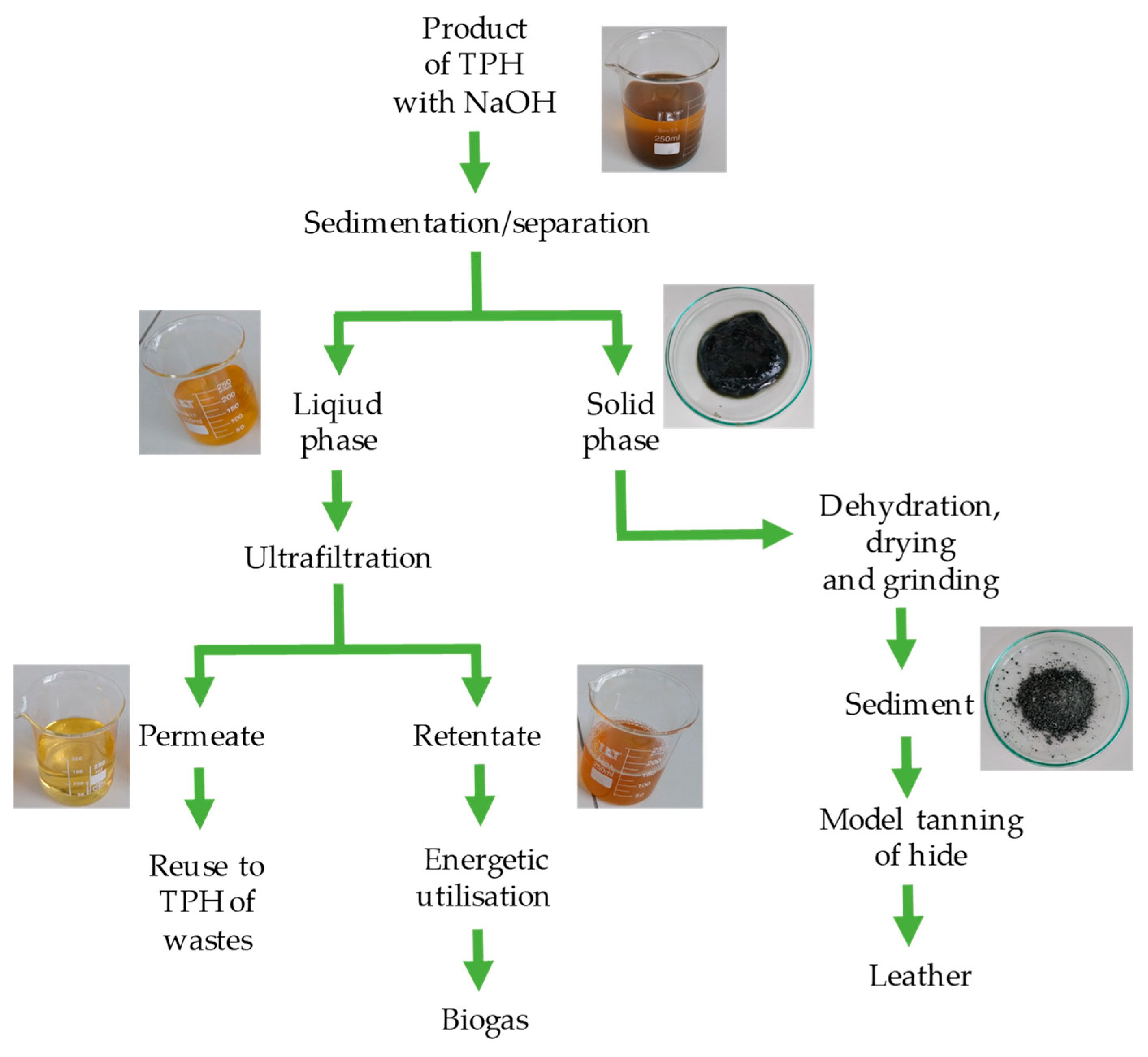
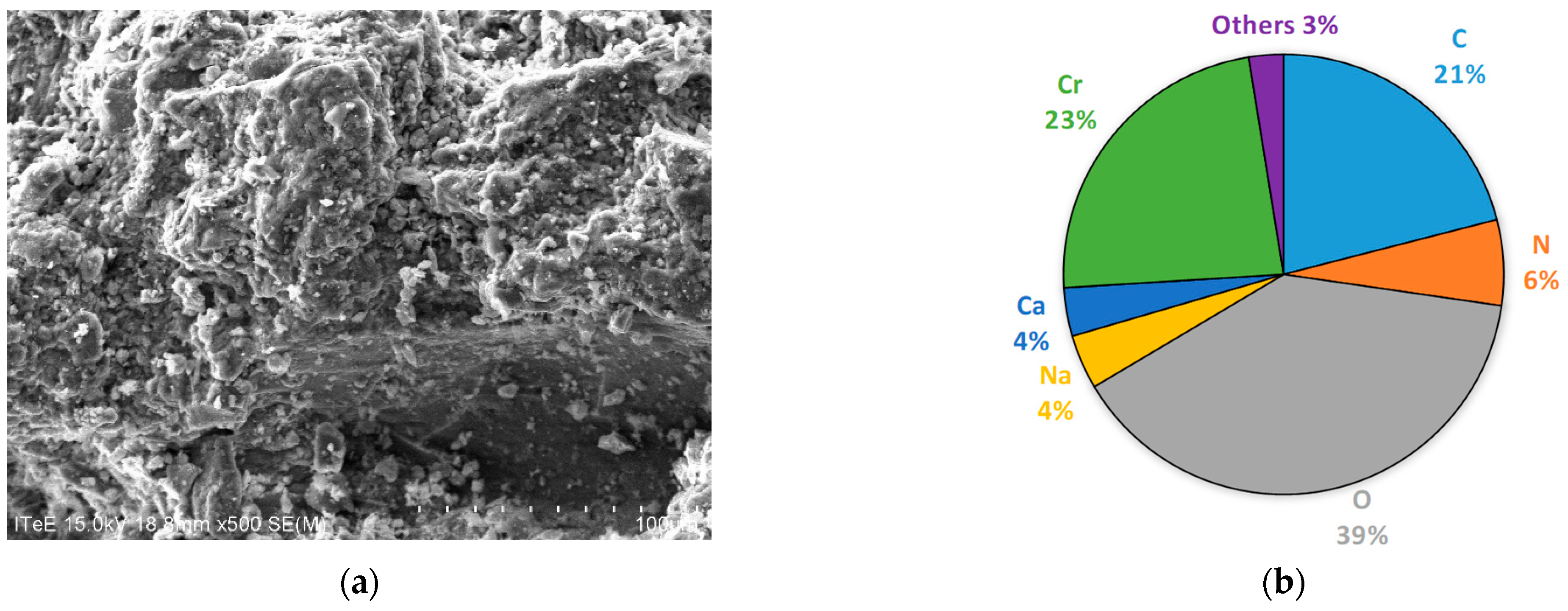
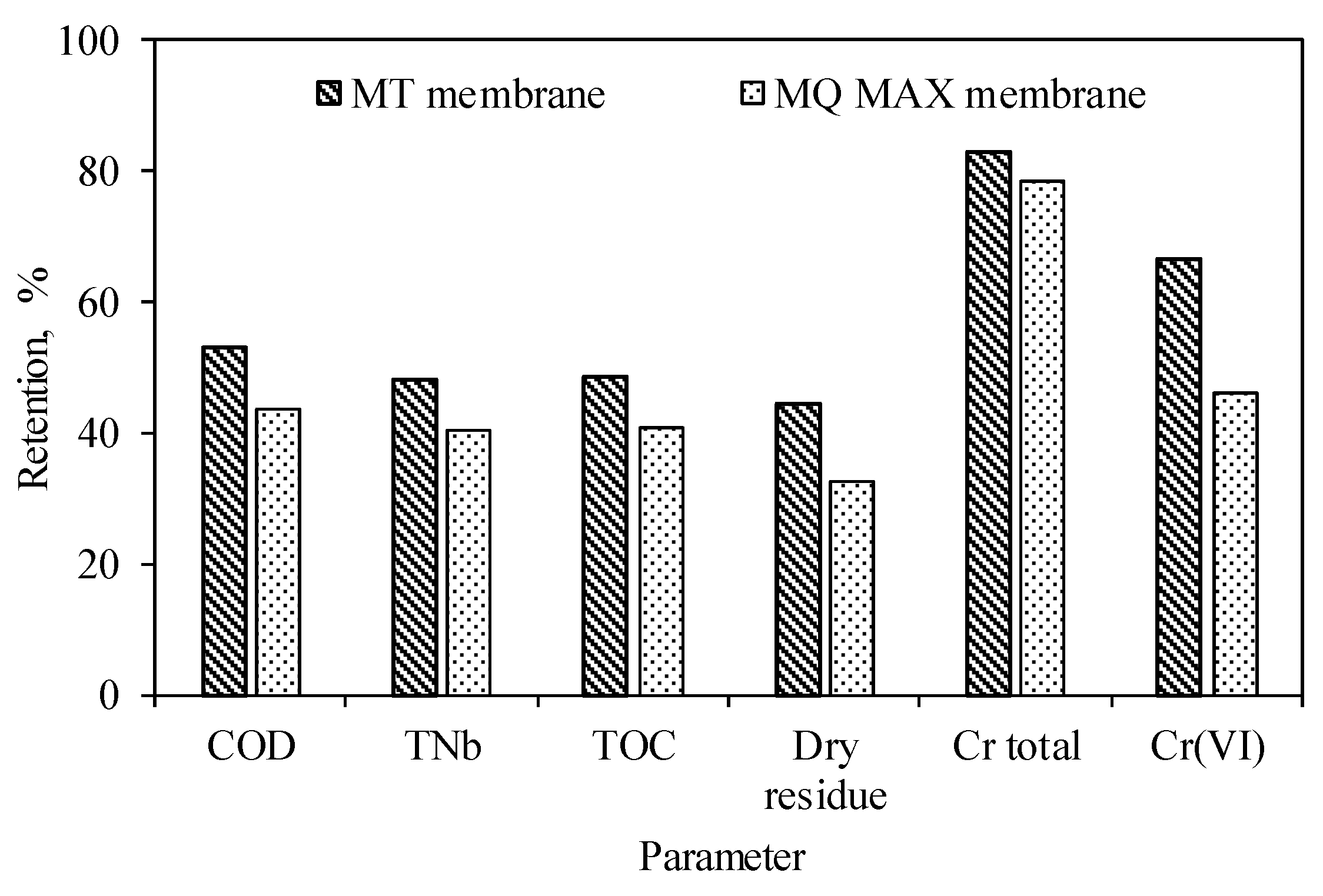

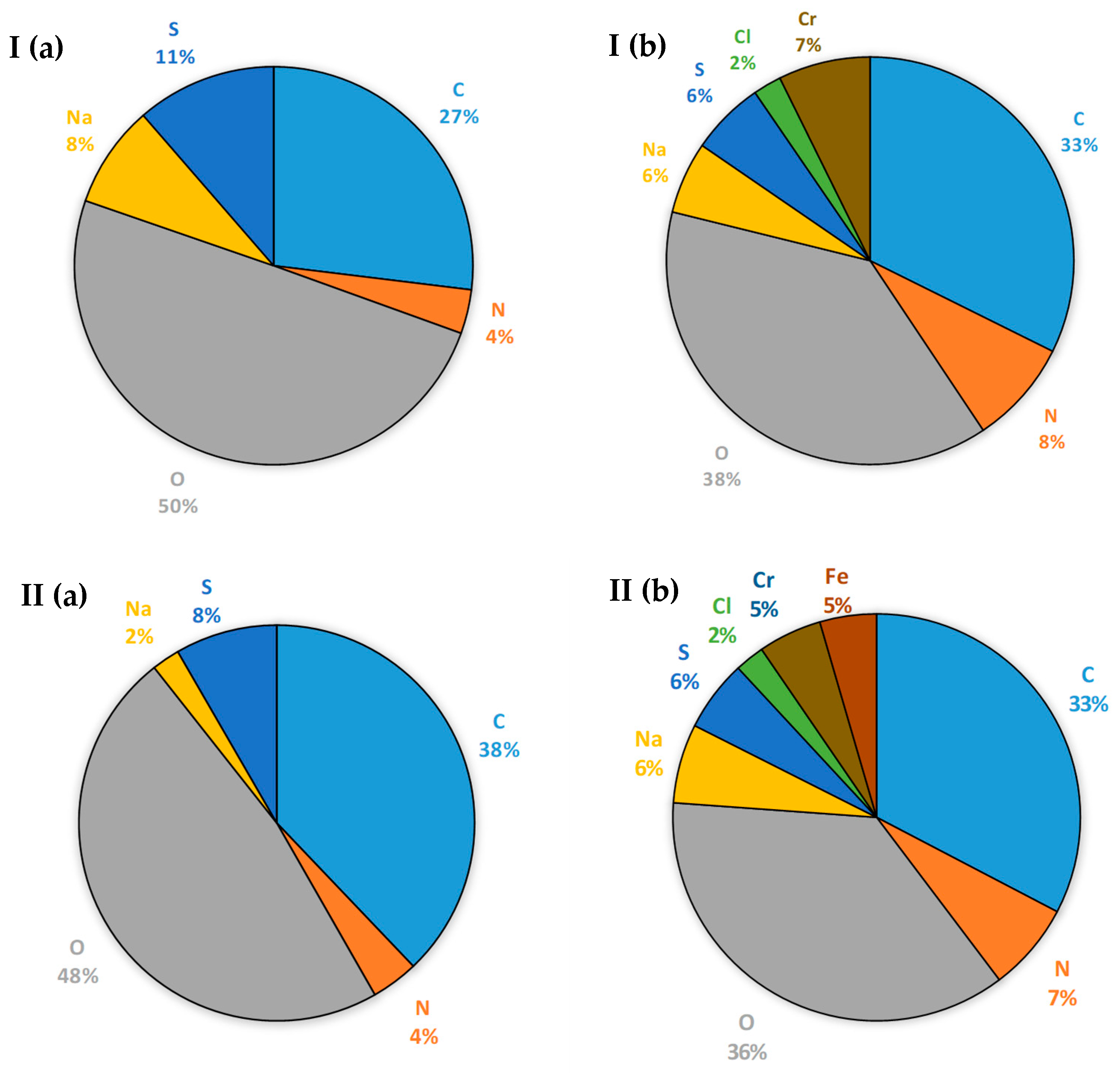
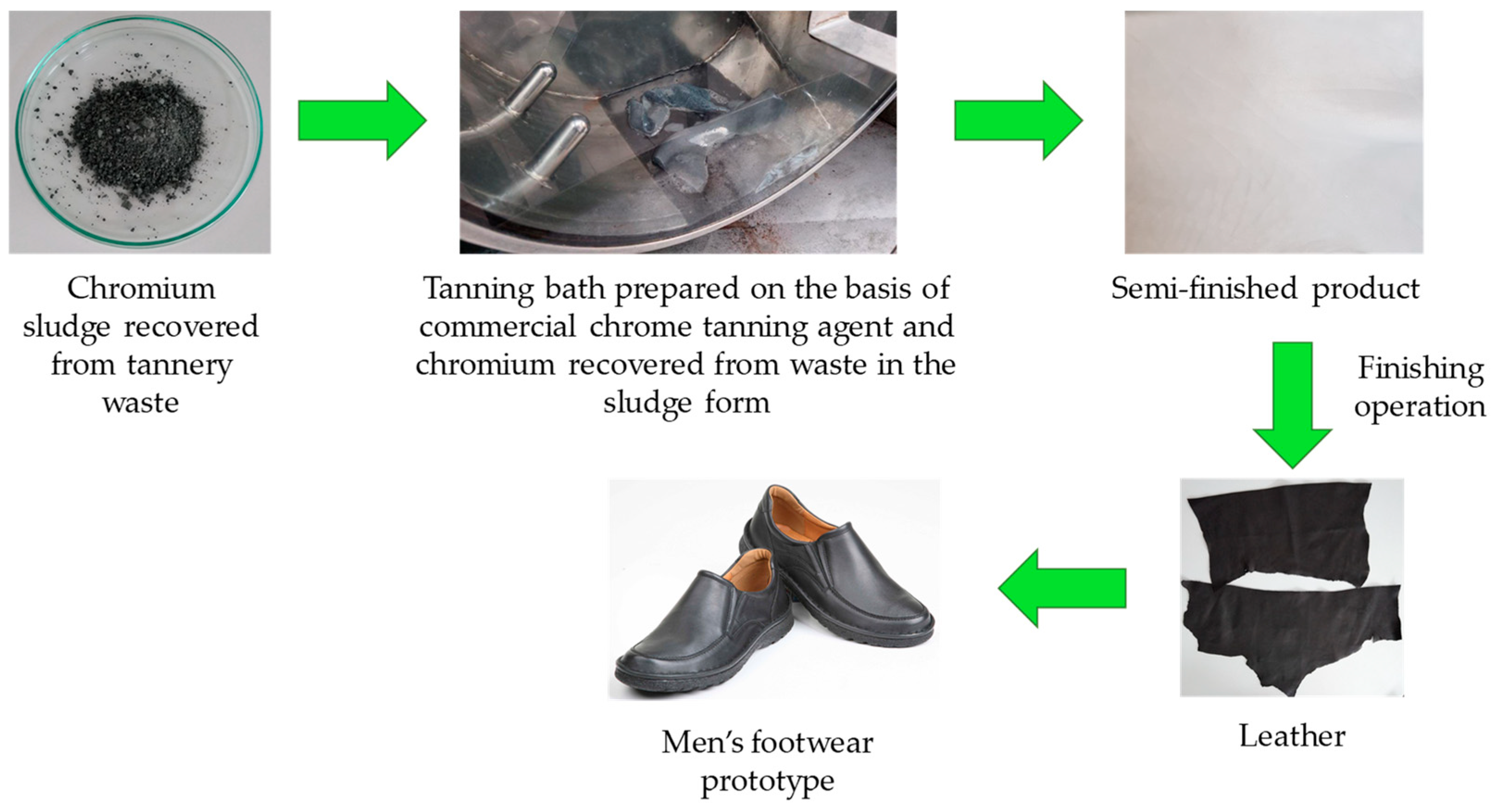


| Parameter | Value |
|---|---|
| Outer Dimensions | 16.51 × 21.3 × 5 cm |
| Active Area Dimensions | 9.7 × 14.7 cm |
| Slot Depth | 0.19 cm |
| Slot Width | 95.3 mm |
| Material | 316 Stainless Steel |
| Parameter | Value |
|---|---|
| pH | 9.433 ± 0.029 |
| Conductivity (mS/cm) | 19.451 ± 0.012 |
| Total chromium (mg/dm3) | 552.0 ± 2.8 |
| Chromium (VI) (mg/dm3) | 2.801 ± 0.084 |
| Chemical oxygen demand (COD) (g O2/dm3) | 69.52 ± 0.69 |
| Total organic carbon (TOC) (g/dm3) | 19.24 ± 0.33 |
| Total nitrogen bound (TNb) (g/dm3) | 10.68 ± 0.10 |
| Chlorides (g/dm3) | 2.697 ± 0.092 |
| Sulphates (g/dm3) | 4.212 ± 0.094 |
| Dry residue (%) | 6.320 ± 0.026 |
| Organic dry residue (% dry matter) | 73.34 ± 0.24 |
| Parameter | Sample 1 | Sample 2 |
|---|---|---|
| Thickness (mm) | 1.27 | 1.27 |
| Tensile strength (N/mm2) | 22.64 | 21.86 |
| Elongation (%) | 50 | 47 |
| Tear strength (N) | 92.83 | 91.38 |
| Brusting factor (lastometer) | 9.9 | 9.5 |
| Adhesion of finish (N/cm] | 4.2 | 5.4 |
| Chromium(III) content converted to Cr2O3 (%) | 4.33 | 4.18 |
| Sample 1 | Hide tanned using a commercial tanning agent | |
| Sample 2 | Hide tanned using chromium recovered from waste subject to basic hydrolysis | |
Disclaimer/Publisher’s Note: The statements, opinions and data contained in all publications are solely those of the individual author(s) and contributor(s) and not of MDPI and/or the editor(s). MDPI and/or the editor(s) disclaim responsibility for any injury to people or property resulting from any ideas, methods, instructions or products referred to in the content. |
© 2024 by the authors. Licensee MDPI, Basel, Switzerland. This article is an open access article distributed under the terms and conditions of the Creative Commons Attribution (CC BY) license (https://creativecommons.org/licenses/by/4.0/).
Share and Cite
Kowalik-Klimczak, A.; Łożyńska, M.; Życki, M.; Schadewell, C.; Fiehn, T.; Woźniak, B.; Flisek, M. Valorisation of Tannery Waste to Recover Chromium with a View to Reusing It in Industrial Practise. Membranes 2024, 14, 136. https://doi.org/10.3390/membranes14060136
Kowalik-Klimczak A, Łożyńska M, Życki M, Schadewell C, Fiehn T, Woźniak B, Flisek M. Valorisation of Tannery Waste to Recover Chromium with a View to Reusing It in Industrial Practise. Membranes. 2024; 14(6):136. https://doi.org/10.3390/membranes14060136
Chicago/Turabian StyleKowalik-Klimczak, Anna, Monika Łożyńska, Maciej Życki, Christian Schadewell, Thomas Fiehn, Bogusław Woźniak, and Monika Flisek. 2024. "Valorisation of Tannery Waste to Recover Chromium with a View to Reusing It in Industrial Practise" Membranes 14, no. 6: 136. https://doi.org/10.3390/membranes14060136







